
Invasive Plants in Georgetown
By Dave Polito
An invasive species is defined as a species that is (1) non-native or alien to the ecosystem under consideration and (2) whose introduction causes or is likely to cause economic or environmental harm, or harm to human health.
A few of the more well-known invasive species in the US are kudzu vines and asian carp in the South and Mississippi and zebra mussels in the Great Lakes. Here in Georgetown many of you are already aware of the European green crab, which is decimating clam populations; the woolly adelgid, which is rapidly killing our eastern hemlock trees; and the brown-tailed moth causing oak and fruit tree defoliation, along with skin and lung irritations among humans.
Some invasive species can be practically controlled; others are nearly impossible to stop. I would like to focus on several plant species invasive to Georgetown which CAN be controlled, but which, if not controlled, can have devastating effects on our properties.
The first and, in my opinion, most important of these is barberry (common and Japanese). These two plants are very similar, but the Japanese barberry turns red in the Fall. These are perennial deciduous shrubs, up to 6 feet tall and wide, usually very branched, with arching canes which can take root at the tip. Canes have a sharp 3/8” spine at each leaf axil. They have red berries which mature in late summer. 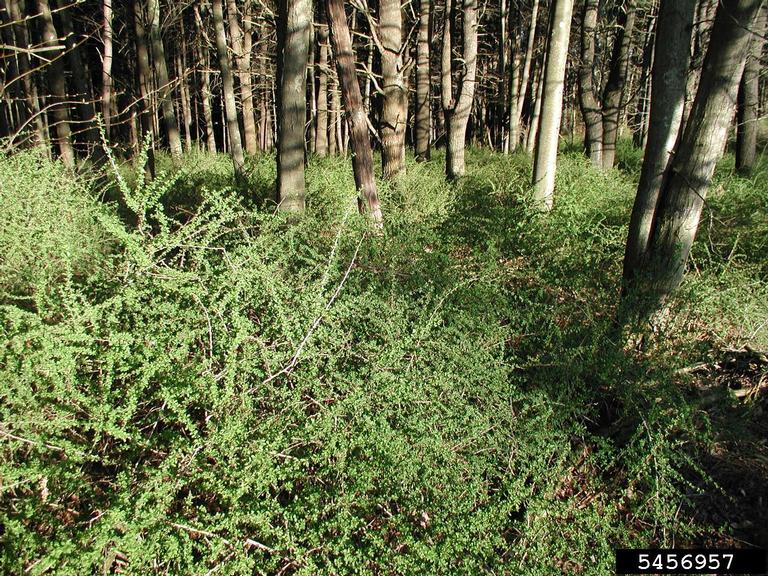

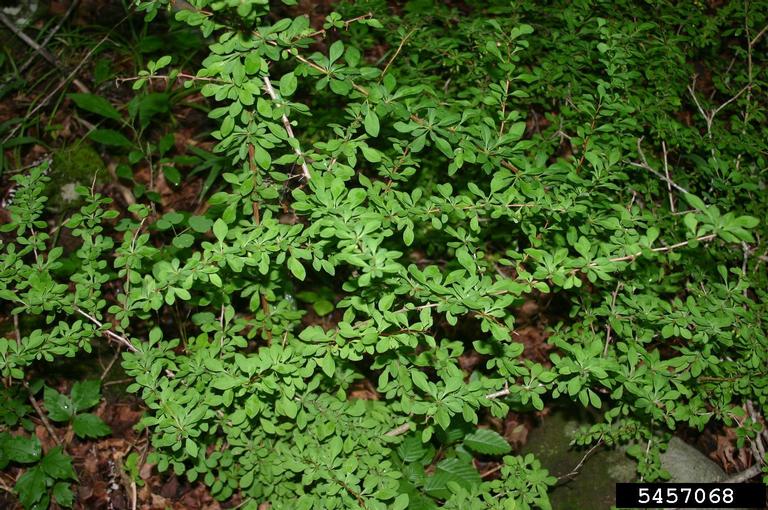
The root interior is bright yellow. Examples of common barberry are readily seen adjacent to the Town Office parking lot, on the north edge. Also, there is a substantial outbreak at mile 1.0 on the West Georgetown Rd. Barberry is fond of disturbed and recently logged areas, and prefers sunlight. It is spreading rapidly in many areas of Georgetown for a number of reasons. Deer do not eat barberry, but as we know they eat almost everything else. As a result, Barberry has little or nothing to compete with in the woodland understory. Also, its ability to root from the tips helps with rapid spread.
Why should you be alarmed about Barberry? For one, it is a thorny beast which can easily become an impenetrable thicket. Also, it harbors a huge number of ticks. Woods containing barberry have 12 times the number of ticks compared with barberry-free woodlands. Once established, it is difficult to eradicate. It will choke out any young trees which our excessive deer herd might miss. If the deer and Barberry are not checked, there will eventually be no young hardwood trees in Georgetown outside of fenced areas free of deer. Even if barberry is removed, if deer are allowed in the area, natural vegetation cannot recover, and barberry will return. Control techniques for barberry include cutting, digging, burning, and herbicides.
The second plant I’d like to mention is Asiatic bittersweet. 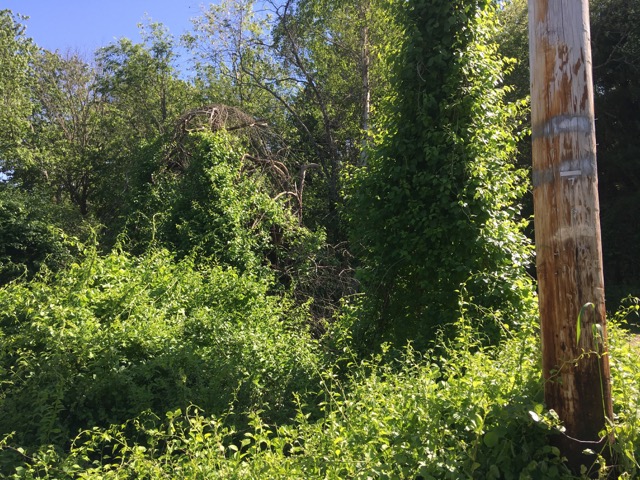 This is a perennial, deciduous woody vine which can wind around mature trees and climb high into the canopy, or sprawl over low-growing vegetation. It is extremely aggressive and dominant, and will choke out all competitors. It can climb into a strong and healthy 60’ tall oak tree and basically strangle it to death. It often leaves woody vines hanging mysteriously from the canopy above, quite strong and flexible.
This is a perennial, deciduous woody vine which can wind around mature trees and climb high into the canopy, or sprawl over low-growing vegetation. It is extremely aggressive and dominant, and will choke out all competitors. It can climb into a strong and healthy 60’ tall oak tree and basically strangle it to death. It often leaves woody vines hanging mysteriously from the canopy above, quite strong and flexible. 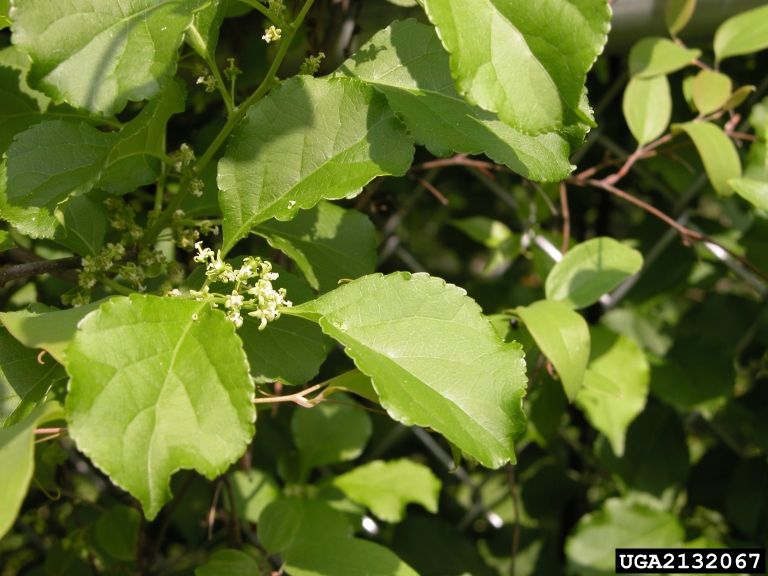
Here in town, bittersweet can be seen climbing into trees at the “turn around here” sign on the Williams Rd., off the West Georgetown Rd. (There is also Barberry at this location.) Control options for bittersweet are pulling, very persistent mowing, and herbicides. Like Barberry, deer do not eat Bittersweet.
Next is giant knotweed. This is a perennial herbaceous shrub which can grow over 12’ high. It has hollow light green stalks which resemble bamboo. Leaves are 6” or more in length. Greenish white flowers are arranged in spikes near the end of the stem. Giant knotweed likes sunny areas along roadsides, disturbed fields, vacant lots and stream banks. In Georgetown, a good example can be found behind the steel guardrail just south of the entrance to the Transfer Station. Old Route 1 in West Bath is heavily infested along the roadsides. Again, giant knotweed is not popular on the deer menu.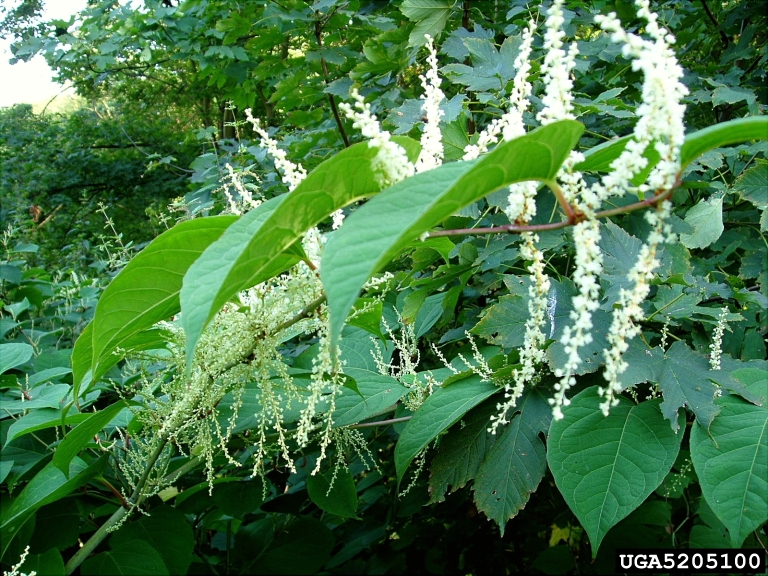
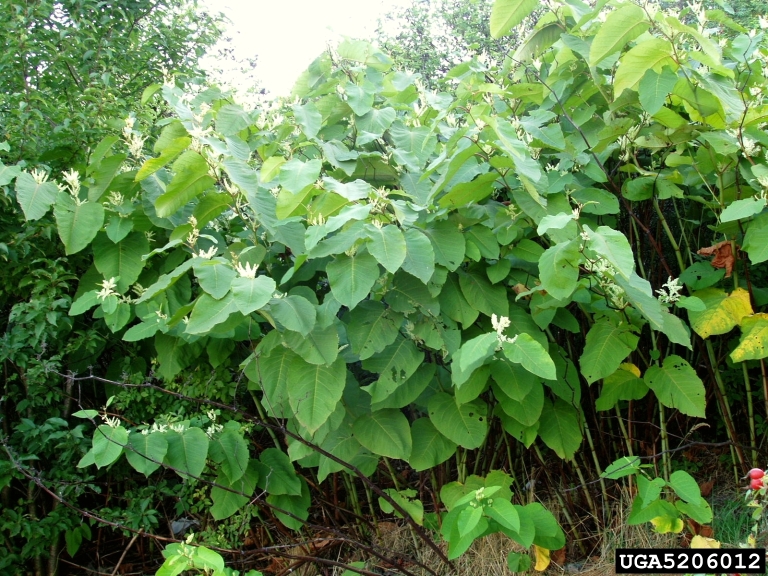
Giant Knotweed spreads aggressively by roots or cut and broken stems. It forms dense thickets and can damage pavement and increase the likelihood of erosion. Control options include cutting and mowing, herbicides, and fostering grass growth as an option.
Last but not least is the Canada thistle. This plant has spiny, deeply lobed leaves and purple flowerheads. It is a perennial noxious weed which spreads by both seeds and horizontal root shoots. Canada thistles flower anytime from late June through August. Control is by herbicides or mowing, but to kill thistles one must mow at least 6 times a season for 4 consecutive seasons, and during this time, new seeds are likely to blow in from elsewhere. Seeds can lie dormant for years. Unchecked thistle easily forms an impenetrable barrier of needlesharp spiny plants, and deer do not eat it. In some locales people have successfully used herds of goats to control these invasives, but this involves erecting temporary electric fencing, and one must protect desired trees or shrubs within the fence from the goats. Repeat visits would be necessary.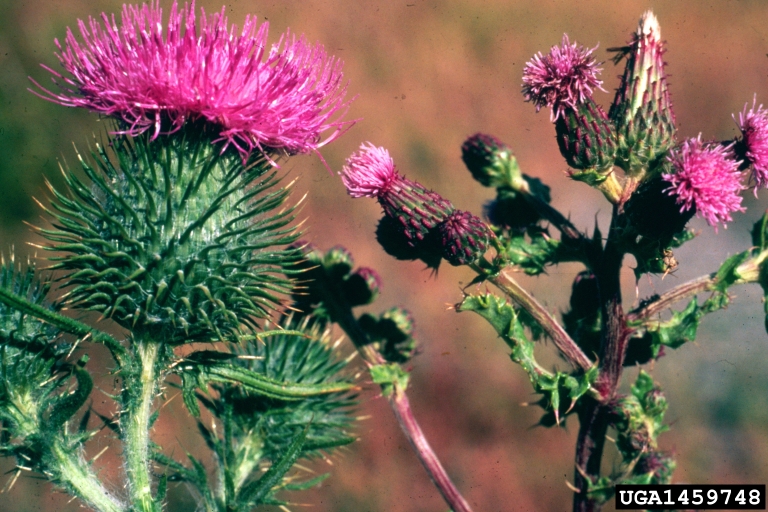
Controlling Georgetown’s runaway deer herd would significantly slow the spread of all these invasive plants by allowing other species to compete with them. 400 years ago Maine was forested with mature white pine, but European settlers cleared almost all the pines for lumber and farmland. When farms were abandoned, mixed hardwood and softwood forests followed. Change is eternal, but few would appreciate land choked with thorny plants of no economic value, making it difficult to walk in the woodlands. If you enjoy hardwood trees for their beauty or for lumber or firewood, and if you enjoy wandering through the woods in relative comfort, you should put serious effort into controlling these invasive on your property. There is significant information online or in libraries detailing identification and control options. Simply type “invasive plant species in Maine” into your search engine, and you are off and running. The future of our forests is at at stake.
Copyright Georgetown Historical Society, Georgetown Tide, Vol. 44 Number 6, April-May 2019. Reprinted with permission. All non-Georgetown specific photo credits to www.bugwood.org through Creative Commons: Barberry — Leslie J. Mehrhoff, U. Conn; Bittersweet closeup — Jan Samanek, Phytosanitary Admin ; Knotweed — Nancy Loewenstein, Auburn U.; Thistle — Steve Dewey, Utah State
For More Great Information on Invasive Plants
Download the Maine Forestry guide to invasive plants here: https://www.maine.gov/dacf/mnap/about/publications/invasive_plant_brochure.pdf
Fact sheet on each invasive plant in Maine: https://www.maine.gov/dacf/mnap/features/invasive_plants/invsheets.htm
Will the forest recover if invasives are removed? One study says, yes: https://news.psu.edu/story/574315/2019/05/14/research/native-forest-plants-rebound-when-invasive-shrubs-are-removed?fbclid=IwAR3rGImH-6kSOg2pQZGJOidBWSJadYzLoHsA4UY-l68JBYxt82Q6tP7p8lw
